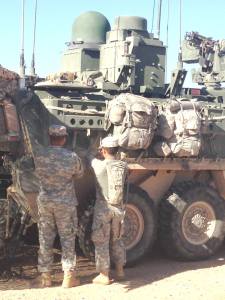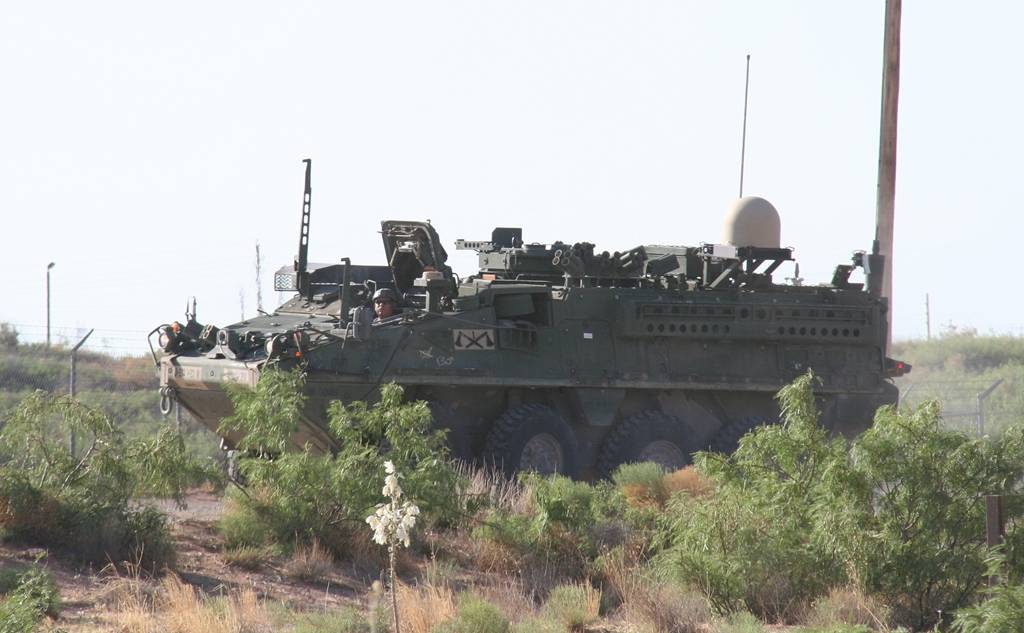FORT BLISS, TEXAS (October 15, 2014) — Within 24 hours the 2nd Brigade, 1st Armored Division (2/1 AD) took on five Improvised Explosive Devices (IEDs), two IED finds, two air assault missions, two route and reconnaissance missions, and two attack missions.
And that’s just the pilot phase.
With the Army’s Network Integration Evaluation (NIE) 15.1 officially beginning its test on October 15, the 2/1 AD will experience a rigorous 19 day operation that pits them against a battalion-size operational force and near-peer competitor equipped with a hybrid threat that includes traditional, cyber and electronic warfare, all spread out over the more than 1.2 million operational acres of Fort Bliss, Texas and White Sands Missile Range, N.M.
“We’ve got a decisive action training environment OPFOR (Opposing Force) scenario, so we’re fighting a near-peer competitor and they have almost every capability we possess,” said Col. Charles J. Masaracchia, 2/1 AD brigade commander. “They are putting us through the paces.”
During an operational test or exercise, the opposing force, which usually includes previously deployed Soldiers, plays the role of the enemy. Its mission is to interject the challenges an Army unit will face during an actual battle.

Soldiers prepared a Stryker equipped with the Army’s new battlefield network (WIN-T) for NIE 15.1. (Photo Credit: U.S. Army)
The 2/1 AD will evaluate new enhancements to WIN-T Increment 2 designed to improve system reliability, simplicity and usability. Soldier feedback from theater, NIEs and user juries helped the Army make WIN-T Increment 2 easier to operate and maintain. Among the many system enhancements are drastically reduced startup and shutdown times; a new, easy to use graphical interface; improved and simplified troubleshooting tools and faster, easier calls to extend radio networks.
“My RTO (radio telephone operator), who I consider one of the best, said that when you first see this equipment you think you’ll never be able to figure it out,” Masaracchia said. “Now, with a few NIEs under his belt, he said it’s as simple as turning on his iPhone and sending a message.”
The NIEs continue to improve, refine and validate the network and the technologies found within the Army’s Capability Set fieldings. Capability Sets act as a network and mission command tool kit, so commanders have the flexibility to draw on the technology they need at the time to complete a mission. They utilize advanced satellite-based systems – augmented by data radios, handheld devices and the latest mission command software – to transmit communications and situational awareness data from command posts to vehicles to dismounted Soldiers.
These networked capabilities are critical to the Army’s push for a more expeditionary force that is able to provide globally responsive, regionally aligned operations at a moment’s notice, even in the most austere and underdeveloped areas of the world.
“When commanders are in their vehicles, it’s critical that they have that information that can change on the battlefield,” said Maj. Stephen Dail, 2/1 AD Brigade communications officer, or S6. “Traditionally they don’t have that, they have voice communications that they get over the radios but they don’t have a picture of the battlefield. So with this on-the-move capability… it feeds that information back and forth. Now, you don’t have to go back to your command post to find out what they may have missed while they’re out in the battle.”
As the technology continues to advance, the Army is focusing on keeping the new capabilities simple and intuitive for Soldiers to operate.
“I’m a ‘comms’ guy, so this is my thing,” said Spec. Gerardo Cabrera, the commander’s RTO for the 2/1 AD. “But when you look at most Soldiers, you put them into these vehicles and they don’t want to know any details about this button or this software program or this network, they want to be able to turn it on and use it.”
WIN-T Increment 2 has already been used by three Brigade Combat Teams in advise and assist missions in Afghanistan, where U.S. forces relied on the capability to stay connected and cover more ground, despite the fact that fixed network infrastructure was being dismantled as U.S. and coalition forces returned home.
NIE 15.1 will also be the first opportunity to utilize new configurations of WIN-T Increment 2 that include network-equipped Stryker vehicles.
Lt. Col. Ryan Worthan, 4th Battalion, 17th Infantry (4-17 Infantry) commander with 1st Stryker Brigade Combat Team, 1st Armored Division, said the networked Strykers integrate systems traditionally found in a static command post and provide them on-the-move.
“It gives us the ability to expand our tactical network,” Worthan said. “Normally we’d be restricted by FM communications and the range associated with that. Overall, this gives us a much higher level of situational awareness on the battlefield as we stretch the network.”
In addition to the operational test of WIN-T Increment 2, NIE 15.1 also includes four Systems Under Evaluation (SUEs) and eight demonstrations of new or emerging capabilities.
The NIEs provide direct Soldier feedback that is then incorporated into the next generation of communications equipment to improve and simplify network systems, leverage industry innovation on emerging capabilities and validate new tactics, techniques and procedures (TTPs) – while also reducing the burden of network integration on operational forces.
“The tests we do are very important for the guys that will have this equipment down range,” said Sgt. Terrance Bond, tactical command post operator with the 4-17 Infantry. “What we’re doing here is a lot of the same operational things that Soldiers will do down range.”
Second Lt. Ian Munoz, battle captain for the 4-17 Infantry battalion tactical operations center, said the feedback they provide adds a depth to the evaluation.
“Soldiers think differently,” Munoz said. “So a lot of the ground level guys are going to find new ways to use it and faster ways to use it. It’s not until the user gets it in their hands that you find the kinks and tricks to using the equipment.”
The NIEs are put on by the Army’s Network Integration TRIAD–consisting of the Brigade Modernization Command, organized under the Army Capabilities Integration Center, Training and Doctrine Command; the System of Systems Engineering and Integration Directorate, organized under the Assistant Secretary of the Army for Acquisition, Logistics and Technology and U.S. Army Test and Evaluation Command.


